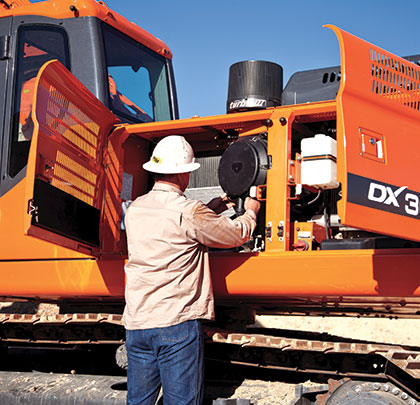Understanding exactly how the Environmental Protection Agency’s (EPA) emission standards—and the interim Tier 4 (iT4) engines—will impact excavators, wheel loaders, and articulated dump trucks (ADTs) can be difficult. The good news for everyone is that the heavy-equipment industry is not recreating the wheel on research and development. Car and light-duty truck manufacturers complied with EPA regulations years earlier and developed emission-control technologies that have been tested in non-road engines.
While each equipment manufacturer has a slightly different engine strategy, most have incorporated sophisticated fuel injection and after-treatment technologies that requires strict adherence manufacturers’ guidelines for maintenance and service.
“Adding new iT4 technologies to reduce emission levels has increased machine cost, but it’s important to remember that the repair or replacement of these new components is even more costly if manufacturers’ maintenance recommendations are not followed. Money can be saved with diligent service intervals and using trained dealership personnel for routine maintenance,” says Chad Ellis, Doosan product manager.
ADVANCED FUEL INJECTION
It’s important to remember that the reason for the EPA’s emission standards is to contribute to cleaner air by reducing harmful pollutants, including particulate matter (PM) and nitrogen oxides (NOx) produced by engines.
Most manufacturers have adopted an advanced fuel-injection design—the high-pressure common rail fuel system—that precisely regulates fuel pressure and injection timing. Its ability to transform fuel into extremely fine mist as it leaves the injectors allows fuel to burn more thoroughly, which results in improved fuel economy, cleaner exhaust, more torque output, and reduced noise.
AFTER-TREATMENT TECHNOLOGIES
The majority of new excavators, wheel loaders, and articulated dump trucks (ADTs) entering the market have been engineered with engine enhancements and/or after-treatment systems that further clean the diesel engine exhaust by using one or a combination of the following: cooled exhaust gas recirculation (CEGR), catalytic oxidation, heat, filtering, or selective catalyst reduction (SCR) with diesel exhaust fluid (DEF).
CEGR systems: Many after-treatment systems incorporate a three-fold approach: cooled exhaust gas recirculation (CEGR), a diesel oxidation catalyst (DOC), and a diesel particulate filter (DPF) with devices commonly combined in a single canister.
CEGR works by recycling a portion of the exhaust gas with fresh air, thereby reducing oxygen levels in the combustion chamber, which helps to reduce NOx formation. The challenge with CEGR is that particulate matter is not reduced to satisfactory levels within the engine and an after-treatment is needed such as the DOC and the DPF.
Since the DPF is typically a ceramic wall flow filtration system that further separates the particulate matter from the exhaust, it will require periodic passive and manual regeneration to reduce the particulate matter into ash using the high temperatures of the exhaust to burn off the accumulated particulate matter.
At approximately 3,000 to 4,000 hours, depending on the specific manufacturer’s recommendations, the accumulated ash from regeneration must be removed from the DPF. Typically, this involves the removal of the DPF from the machine for cleaning and/or refurbishing. “DPF maintenance greatly depends on the machine’s prolonged idle time. Lower-rpm operation will increase the frequency of service,” Ellis says. Because the accumulated ash is considered hazardous material, Ellis recommends that service only be performed by the dealer or an authorized DPF service provider.
SCR systems: A second system is the selective catalyst reduction (SCR) after-treatment technology. SCR systems are used in conjunction with engines that have been optimized to reduce particulate matter (PM). The use of SCR reduces NOx using an additional liquid called diesel exhaust fluid (DEF) consisting of water and ammonia for the after-treatment of the exhaust gases.
Ellis says that for every 100 gallons of diesel fuel consumed by the engine, approximately 5 gallons of DEF will be used. For example, if a DEF tank capacity is 15 gallons, the DEF will need to be refilled after about 300 gallons of diesel fuel, so operators will typically want to top off the DEF in conjunction with refueling.
According to Aaron Kleingartner, Doosan segment application marketing manager, since DEF is a water-based solution, special precautions should be taken in cold climates. “The DEF will begin to crystallize and freeze at about 12 degrees Fahrenheit, but the systems and EPA regulations are designed to accommodate that,” says Kleingartner.
SPECIALLY-FORMULATED FLUIDS
Oil: All machines using the CEGR + DOC/DPF technologies will require the use of American Petroleum Institute (API)-rated CJ-4 (sometimes referred to as low-ash oil) to help reduce the amount of particulate matter in the DPF.
Fuel: All machines using the CEGR + DOC/DPF technologies will require ultra-low sulfur diesel (ULSD). The catalyst system used with iT4 engines is dependent on ULSD, which has significantly less sulfur compared to prior diesel fuels (15 ppm versus 500 ppm).
CJ-4 OIL REQUIREMENT
With the CJ-4 oil requirement for iT4-compliant engines, owners and operators are curious about how to dispose of their current oil. Kleingartner has a simple solution.
He is quick to emphasize that it’s unlikely whole fleets will transition to the new emission-control systems at one time. Therefore, he suggests using the new oil in the new iT4 machines and using the current supply of old oil in older machines. Once that supply of old oil is depleted, use the new API CJ-4 oil in all machines.
“The nice thing about the new oil is that it’s backwards compatible. Moving forward, our suggestion is that you transition into this new oil and use it across your entire fleet. That way you won’t accidently use the wrong oil,” says Kleingartner. ■
For More Information:
For more information about Doosan Infracore Construction Equipment America, visit www.doosanequipment.com.
_________________________________________________________________________
Modern Contractor Solutions, February 2013
Did you enjoy this article?
Subscribe to the FREE Digital Edition of Modern Contractor Solutions magazine.

New Maintenance Mindset: Understanding iT4 technologies


